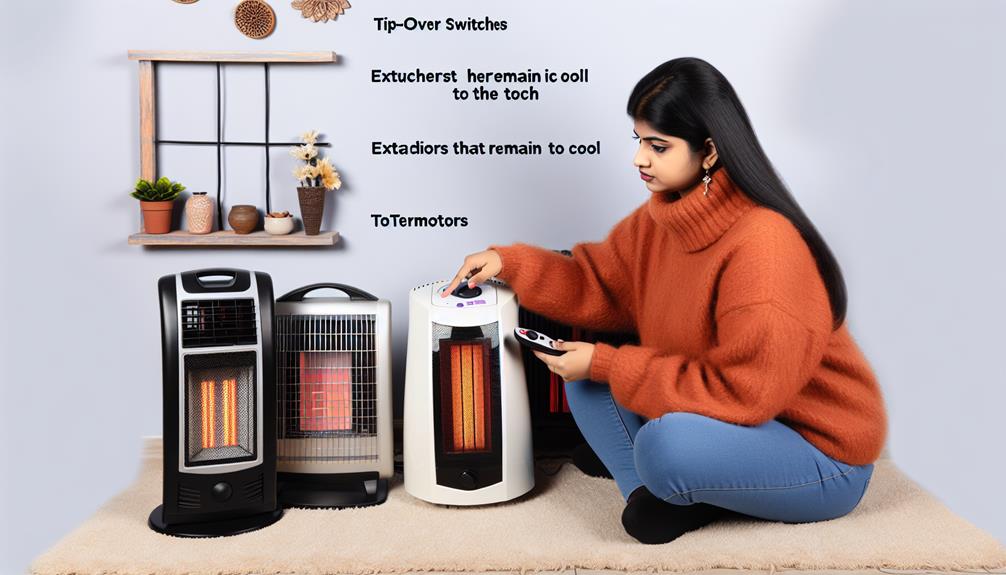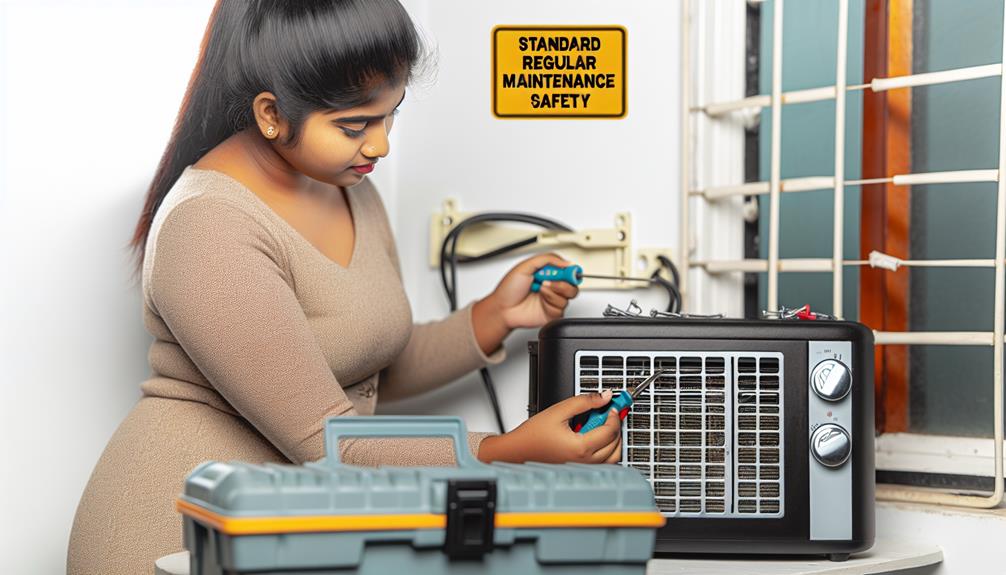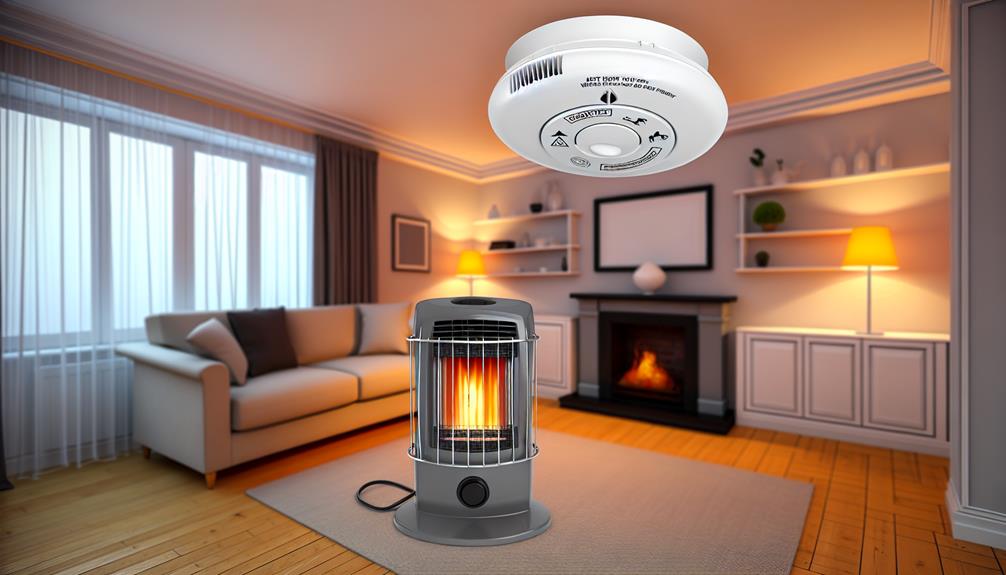Nearly 80% of home heating fire deaths are attributed to portable heaters—a startling statistic that places a significant responsibility on your shoulders when you bring one into your home. As you seek to create a cozy environment during the chillier months, it's crucial to prioritize safety to protect yourself, your loved ones, and your property. You'll need to be well-versed in selecting the right heater, understanding the intricacies of safe placement, and staying vigilant with regular maintenance. Moreover, being familiar with the built-in safety features and adopting safe usage practices are non-negotiable aspects of portable heater ownership. To ensure your warmth doesn't come with unwarranted risks, let's explore the critical measures you should incorporate into your routine, and perhaps, uncover some lesser-known tips that could be the difference between comfort and calamity.
Key Takeaways
- Consider heating capacity and room size
- Look for energy-saving features
- Familiarize yourself with safety features like automatic shut-off and tip-over protection
- Follow proper placement and maintenance guidelines
Choosing the Right Heater

When selecting a portable heater, it's crucial to consider your specific needs and the characteristics of the space you intend to warm. The heating capacity of a portable heater is a primary factor; it determines the size of the area the unit can effectively heat. Typically measured in British Thermal Units (BTUs) or watts, this capacity should align with the square footage of your room. It's not just about picking the most powerful heater; an oversized heater will consume more energy than necessary, while an undersized one will run continuously without adequately heating the space.
Energy efficiency is another key consideration. You'll want a heater that provides the most warmth for the least amount of electricity consumed. Look for models with energy-saving modes, adjustable thermostats, or programmable timers that help minimize power usage. These features allow the heater to turn off or lower its output when the desired temperature is reached, thus conserving energy and saving you money on your electricity bill.
Remember that higher wattage doesn't always equate to better performance. It's about how effectively the heater converts electrical energy into heat and distributes it throughout the room. Some heaters may boast a high wattage but poor design, leading to inefficient heating.
Be cautious and do your research. Read reviews and compare specifications. Check for safety features like automatic shut-off or tip-over protection, which are critical for preventing accidents. By being thorough in your selection process, you can ensure that the portable heater you choose is both effective and energy-efficient, providing comfort without excessive cost or risk.
Proper Heater Placement
Having selected the ideal portable heater, it's equally important to consider where you'll place it to ensure maximum efficiency and safety. The right location can drastically reduce the risk of fire and provide even heating throughout the room. Heater clearance and ventilation requirements are crucial factors that you cannot afford to overlook.
Here are three vital guidelines to follow when placing your portable heater:
- Maintain Adequate Clearance: Keep the heater at least three feet away from any combustible materials such as curtains, furniture, bedding, or clothing. This distance is a safety standard that helps prevent these materials from catching fire due to the heater's intense heat.
- Ensure Proper Ventilation: Avoid placing your heater in an enclosed space. Portable heaters need a well-ventilated area to operate safely, reducing the risk of carbon monoxide buildup, especially for combustion-type heaters. Always check the manufacturer's instructions for specific ventilation requirements.
- Place on a Flat, Stable Surface: Position your heater on a level surface to prevent it from tipping over. Surfaces like carpets or rugs can catch fire if the heater gets too hot, so it's safer to use it on tile or hardwood flooring. If that's not possible, use a metal or ceramic surface to place the heater on.
Regular Maintenance Checks

To ensure your portable heater operates safely and efficiently, it's crucial to perform regular maintenance checks. Establishing a routine inspection frequency is essential in preventing hazards and extending the life of your device. You wouldn't ignore your car's maintenance schedule, and the same principle applies to your portable heater.
Firstly, you must inspect the power cord for any signs of damage, such as fraying or kinks, which could indicate a potential fire risk. If you find any damage, replace the cord immediately. Don't attempt to repair it with tape or other temporary fixes. Next, check the heater's exterior and grilles for dust accumulation. A buildup of dust and debris can obstruct airflow and overwork the heater's components, making it less efficient and more likely to overheat.
Component lubrication is another maintenance task that can't be overlooked. Moving parts, like fans within your heater, require periodic lubrication to function smoothly. Refer to your heater's manual to understand the specific lubrication needs of your model, as using the wrong type of lubricant can cause more harm than good.
Additionally, inspect the heating element periodically to ensure it's in good working order. An element that's worn out or coated with dust could become a fire hazard or fail to work at all. It's also wise to test any safety features, like automatic shut-off mechanisms, to confirm they're operational.
Understanding Safety Features
Familiarizing yourself with your portable heater's safety features is crucial for preventing accidents and ensuring a secure heating experience. The importance of understanding these features cannot be overstated; they are designed to protect you, your loved ones, and your property from potential hazards associated with portable heaters. Let's delve into some of these essential safety features:
- Automatic Shutoff: This is a critical feature that can greatly reduce the risk of fire or overheating. Heaters equipped with automatic shutoff mechanisms are designed to turn off under certain conditions, such as when the unit reaches a temperature that is too high or if it runs for an extended period. It's an invaluable component that acts as a fail-safe, ensuring the heater doesn't become a danger if left unattended.
- Tip Over Protection: Accidents happen, and portable heaters can get knocked over. That's where tip over protection comes in. This feature instantly turns the heater off if it's tipped over, minimizing the risk of fire. Always check to make sure your heater has this feature, especially if you have children or pets that could accidentally knock it down.
- Overheat Protection Sensor: Besides the automatic shutoff, many heaters come with a built-in sensor that detects when internal components reach unsafe temperatures. If an overheat condition is detected, the sensor will shut down the heater to prevent any damage or fire risk.
Safe Usage Practices

When operating a portable heater, it's imperative that you adhere to specific guidelines to ensure your safety and the well-being of those around you. The heating capacity of your device is designed for a specific area size, so always use it in a room that matches its capacity. This not only maximizes energy efficiency but also minimizes overheating risks.
Here's a concise table to help you remember key safe usage practices:
| Practice | Explanation |
|---|---|
| Proper Placement | Keep the heater on a flat, stable surface away from flammable materials. |
| Supervision | Never leave a heater unattended while it's on. |
| Outlet Check | Plug directly into an outlet, not an extension cord, to prevent electrical hazards. |
| Maintenance | Regularly clean and inspect your heater for any signs of damage or wear. |
| Off Before Sleep | Always turn off the heater before going to sleep or leaving the room. |
Frequently Asked Questions
How Do I Safely Use a Portable Heater if I Have Pets or Small Children in the House?
Worried about keeping little ones and furry friends safe around heat sources? You've got to master child-proofing techniques and pet safety. Always keep heaters out of reach, use barriers, and never leave them unattended. It's crucial to secure cords and choose models with automatic shut-off features. You'll maintain a cozy, hazard-free zone by staying vigilant and using these precautions. Remember, an ounce of prevention is worth a pound of cure.
Can I Use an Extension Cord With My Portable Heater, and if So, What Type Should I Use?
You shouldn't use an extension cord with your portable heater. If you must, ensure it's a heavy-duty one with a proper cord rating for the heater's power requirements. Always do a safety inspection of both the cord and heater beforehand. Remember, extension cords are temporary solutions and can pose a fire risk if not used correctly. It's best to plug heaters directly into a wall outlet whenever possible.
What Should I Do if My Portable Heater Starts Emitting a Strange Smell or Noise?
If your heater is serenading you with unexpected odors or sounds, it's time to act. Don't shrug it off; these could be telltale signs of faulty wiring or a cry for care. Immediately switch off the device, unplug it, and don't use it. Check your maintenance schedule—has it been a while? You'll want to consult a professional to ensure your cozy companion is both safe and sound for future use.
How Do I Dispose of or Recycle an Old, Non-Functioning Portable Heater?
If you've got an old, broken portable heater, don't just toss it in the trash. Heater materials can often be recycled. Check with local recycling centers to see if they accept electrical appliances. They'll guide you on how to properly dispose of it. Remember, it's crucial to handle disposal carefully to avoid environmental harm. So, you're not just clearing out clutter, you're also doing your part in being eco-friendly.
Are There Any Health Risks Associated With Using Portable Heaters, Such as Impacts on Air Quality or Respiratory Issues?
Absolutely, using portable heaters can affect your health, especially if they're not managed properly. They can decrease indoor humidity and compromise air quality, which might lead to respiratory issues. It's crucial to maintain proper ventilation when using these devices. You've got to balance staying cozy with ensuring that your home's air stays fresh and healthy. Always follow the manufacturer's safety instructions to minimize any health risks. Stay warm but stay safe!
